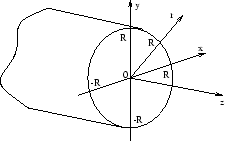Back to Kemp Acoustics Home




Next: Loss-less propagation
Up: Multimodal equations in a
Previous: Multimodal equations in a
Contents
Solutions for a cylinder
In this section we will show the solutions of the wave equation for
pipes of uniform cross-section.
Consider a cylinder of radius  (cross-sectional area is
(cross-sectional area is  )
as shown in figure 2.3.
)
as shown in figure 2.3.
Figure 2.3:
Cylindrical waveguide with radius 
 |
First we will examine the case of loss-less
propagation along a duct of infinitely hard walls. No flow is allowed through
the walls so the gradient of the pressure along the radial direction must
equal zero at the wall. This boundary condition will be used to derive
expressions for the mode profiles on the x-y plane, and the corresponding
wavenumbers along the different dimensions. The modes in a uniform cylindrical
duct will then be illustrated in a colour pressure map. We then go on to
show the solutions for lossy propagation.
The profile of the various modes are the eigenfunctions defined in
equation (2.31). In general, the solution need not be
axially symmetric. Musical wind instruments are, however, generally designed
so that the internal profile has no sharp sideways steps and only feature
relatively gradual bends. This means that the behaviour may be modelled
accurately
by approximating the profile by a series of concentric cylinders.
Only axially symmetric modes will have an effect on the response of
an instrument assuming the excitation is also axi-symmetric. The present
discussion will therefore be limited to axi-symmetric modes only.
This approximation ignores the fact that the excitation from
a brass instrument player's lips is not perfectly axially symmetric.
Subsections
Back to Kemp Acoustics Home




Next: Loss-less propagation
Up: Multimodal equations in a
Previous: Multimodal equations in a
Contents
Jonathan Kemp
2003-03-24
